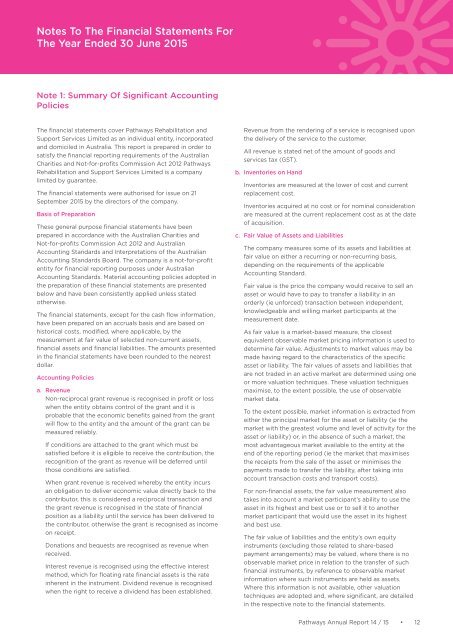2015 Pathways Annual report
2015 Pathways Annual report
2015 Pathways Annual report
Create successful ePaper yourself
Turn your PDF publications into a flip-book with our unique Google optimized e-Paper software.
Notes To The Financial Statements For<br />
The Year Ended 30 June <strong>2015</strong><br />
Note 1: Summary Of Significant Accounting<br />
Policies<br />
The financial statements cover <strong>Pathways</strong> Rehabilitation and<br />
Support Services Limited as an individual entity, incorporated<br />
and domiciled in Australia. This <strong>report</strong> is prepared in order to<br />
satisfy the financial <strong>report</strong>ing requirements of the Australian<br />
Charities and Not-for-profits Commission Act 2012 <strong>Pathways</strong><br />
Rehabilitation and Support Services Limited is a company<br />
limited by guarantee.<br />
The financial statements were authorised for issue on 21<br />
September <strong>2015</strong> by the directors of the company.<br />
Basis of Preparation<br />
These general purpose financial statements have been<br />
prepared in accordance with the Australian Charities and<br />
Not-for-profits Commission Act 2012 and Australian<br />
Accounting Standards and Interpretations of the Australian<br />
Accounting Standards Board. The company is a not-for-profit<br />
entity for financial <strong>report</strong>ing purposes under Australian<br />
Accounting Standards. Material accounting policies adopted in<br />
the preparation of these financial statements are presented<br />
below and have been consistently applied unless stated<br />
otherwise.<br />
The financial statements, except for the cash flow information,<br />
have been prepared on an accruals basis and are based on<br />
historical costs, modified, where applicable, by the<br />
measurement at fair value of selected non-current assets,<br />
financial assets and financial liabilities. The amounts presented<br />
in the financial statements have been rounded to the nearest<br />
dollar.<br />
Accounting Policies<br />
a. Revenue<br />
Non-reciprocal grant revenue is recognised in profit or loss<br />
when the entity obtains control of the grant and it is<br />
probable that the economic benefits gained from the grant<br />
will flow to the entity and the amount of the grant can be<br />
measured reliably.<br />
If conditions are attached to the grant which must be<br />
satisfied before it is eligible to receive the contribution, the<br />
recognition of the grant as revenue will be deferred until<br />
those conditions are satisfied.<br />
When grant revenue is received whereby the entity incurs<br />
an obligation to deliver economic value directly back to the<br />
contributor, this is considered a reciprocal transaction and<br />
the grant revenue is recognised in the state of financial<br />
position as a liability until the service has been delivered to<br />
the contributor, otherwise the grant is recognised as income<br />
on receipt.<br />
Donations and bequests are recognised as revenue when<br />
received.<br />
Interest revenue is recognised using the effective interest<br />
method, which for floating rate financial assets is the rate<br />
inherent in the instrument. Dividend revenue is recognised<br />
when the right to receive a dividend has been established.<br />
Revenue from the rendering of a service is recognised upon<br />
the delivery of the service to the customer.<br />
All revenue is stated net of the amount of goods and<br />
services tax (GST).<br />
b. Inventories on Hand<br />
Inventories are measured at the lower of cost and current<br />
replacement cost.<br />
Inventories acquired at no cost or for nominal consideration<br />
are measured at the current replacement cost as at the date<br />
of acquisition.<br />
c. Fair Value of Assets and Liabilities<br />
The company measures some of its assets and liabilities at<br />
fair value on either a recurring or non-recurring basis,<br />
depending on the requirements of the applicable<br />
Accounting Standard.<br />
Fair value is the price the company would receive to sell an<br />
asset or would have to pay to transfer a liability in an<br />
orderly (ie unforced) transaction between independent,<br />
knowledgeable and willing market participants at the<br />
measurement date.<br />
As fair value is a market-based measure, the closest<br />
equivalent observable market pricing information is used to<br />
determine fair value. Adjustments to market values may be<br />
made having regard to the characteristics of the specific<br />
asset or liability. The fair values of assets and liabilities that<br />
are not traded in an active market are determined using one<br />
or more valuation techniques. These valuation techniques<br />
maximise, to the extent possible, the use of observable<br />
market data.<br />
To the extent possible, market information is extracted from<br />
either the principal market for the asset or liability (ie the<br />
market with the greatest volume and level of activity for the<br />
asset or liability) or, in the absence of such a market, the<br />
most advantageous market available to the entity at the<br />
end of the <strong>report</strong>ing period (ie the market that maximises<br />
the receipts from the sale of the asset or minimises the<br />
payments made to transfer the liability, after taking into<br />
account transaction costs and transport costs).<br />
For non-financial assets, the fair value measurement also<br />
takes into account a market participant’s ability to use the<br />
asset in its highest and best use or to sell it to another<br />
market participant that would use the asset in its highest<br />
and best use.<br />
The fair value of liabilities and the entity’s own equity<br />
instruments (excluding those related to share-based<br />
payment arrangements) may be valued, where there is no<br />
observable market price in relation to the transfer of such<br />
financial instruments, by reference to observable market<br />
information where such instruments are held as assets.<br />
Where this information is not available, other valuation<br />
techniques are adopted and, where significant, are detailed<br />
in the respective note to the financial statements.<br />
<strong>Pathways</strong> <strong>Annual</strong> Report 14 / 15 • 12


